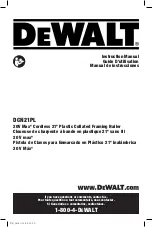
Complete '
cartridge
' assembly
A
FTER ANY MAINTENANCE TO THE TOOL
,
REMOVE
ALL
CLEATS
BEFORE CONNECTING AIR AND ACTUATE THE
TOOL REPEATEDLY OVER A PIECE OF WOOD OR
SUBFLOORING TO INSURE PROPER OPERATION
.
ASSEMBLING THE VALVE
All the components required to drive nails in and reset the tool
are packed in a cartridge assembly which is simply inserted into
the tool. This section describes how to assemble all the
components together. However, it is usually not necessary to
completely disassemble the valve. Refer to next section,
"
C
LEANING THE VALVE
" for more information on how to open the
tool for regular maintenance. The following procedure assumes
that the gate/foot assembly (Q-029/Q-032) along with the resting
block Q-034 are already installed. Refer to the "
Replacement
Parts
" document for a complete list and schematic of the tool.
1.
It is usually not required to separate the head disk Q-001A
from the head cap Q-001. If necessary, insert the head disk
Q-001A firmly in place into the head cap Q-001.
2.
Align the inner shape of the head cap Q-001 with the shape
of the head Q-006 and snap the cap in place. It is usually
not required to remove the head cap from the head.
3.
Check the condition of all rings and seals on the actuator
Q-042, actuator cap Q-044 and main valve Q-043.
4.
Lightly lubricate actuator Q-042 as shown and insert it into
valve Q-043.
5.
Lightly lubricate the permanent seal of actuator cap Q-044
as shown. Do not lubricate the small o-ring (see part
Q-044C on schematic). Insert the actuator cap as shown
and forcibly snap it into the actuator Q-042
6.
Insert the valve sub-assembly completely into the head
Q-006.
7.
Check that the band-valve Q-018A is properly installed onto
the main cylinder Q-018. Screw the cylinder Q-018
completely onto the head body Q-006 and tighten firmly by
hand. Take care not do damage the threads. Pull down the
valve Q-043 to sit it onto the cylinder.
A
LWAYS CHECK THAT THE CYLINDER IS COMPLETELY
SCREW
-
ON THE HEAD BEFORE INSERTING THE ASSEMBLY
INTO THE TOOL
.
T
HE CYLINDER WILL LOOSEN
-
UP WHEN
THE CARTRIDGE IS TAKEN
-
OFF THE TOOL
.
A
LWAYS PULL DOWN THE VALVE AGAINST THE CYLINDER
BEFORE INSERTING THE HEAD ASSEMBLY
.
8.
Check that the piston sub-assembly, including rings and
driving blade, is sliding easily into the cylinder Q-018. It
should offer some resistance, but if it moves too easily, it
may be required to replace the piston wear-ring Q-022A.
9.
Insert the seal bushing Q-025B in the lower section of main
body Q-006 and engage it onto the upper portion of the
gate/foot assembly (Q-029/Q-032). A flat screwdriver can
help location the seal bushing correctly. Use the wooden
handle of the hammer to tap the seal bushing completely in
place. It is usually not necessary to pull-out the seal bushing
Q-025B for maintenance.
10. With the tool in the upright position, push the bumper
Q-025A in place, indexed onto the seal bushing Q-025B and
use the wooden handle to seat the bumper in position.
11. Insert the piston sub-assembly into the main body Q-016
and engage the driving blade Q-023 in the seal bushing
opening. Depress the safety contact Q-062 to ensure that
the driving blade has engaged the gate/foot assembly
guiding channel.
12. Loosen the lock P-616D and insert the whole head
assembly into the main body Q-016; the main cylinder
Q-018 engaging onto the piston assembly. Screw the head
assembly completely. Take care not do damage the
threads. Rotate the lock clockwise and tighten with the Allen
key using moderate force.
NEVER
APPLY THREADLOCKER OR ADHESIVE ONTO
CYLINDER OR HEAD THREADS
.
I
T IS MOST IMPORTANT THAT THE MAIN CYLINDER BE
FULLY SCREWED
&
TIGHTENED ONTO THE HEAD
ASSEMBLY BEFORE BEING INSERTED INTO THE MAIN
BODY
.
A
FTER REASSEMBLY
,
ALWAYS ACTUATE THE TOOL
REPEATEDLY
WITHOUT
CLEATS
AGAINST A PIECE OF
WOOD TO INSURE PROPER OPERATION
.
This tool features a head lock to
maintain firmly in place the head
assembly during operation. Before
inserting the head assembly,
ensure that the P-616D lock is free
to swivel and rotate it away from
the head opening. After inserting
the head assembly in place, rotate
the P-616D lock and tighten with
the Allen key using moderate force.
To remove the head assembly, simply unscrew the P-616D
screw ¼ turn and rotate it counter-clockwise.
CLEANING THE VALVE
If the tool becomes sluggish or does not set the cleat, it may
indicate excessive dirt, dust, other particles, or even water, in the
head assembly, thereby impeding the cycling of the valve. The
first step in troubleshooting is to clean up the head assembly.
Summary of Contents for Q550
Page 11: ......





























